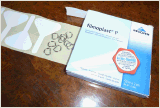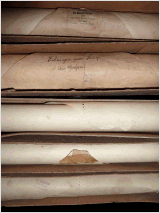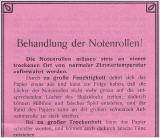Repairing piano rolls
Though the up to 100 years old piano rolls are often still well preserved, many rolls will be marked by smaller or bigger defects. If the defect is small, the piano rolls can be repaired for a reasonable price. Often, the take-up hook has broken off. There are repair sets available that consist of a new hook and an adhesive triangle for the beginning - as seen in the accompanying photo. If the piano roll has torn, a special repair tape from book restoration may fix it (see photo). Do not use customary scotch tapes or similar, because they will damage the paper, are not flexible enough and will slowly shrink, damaging the roll beyond repair.
Piano rolls with deformations or tears
If the piano roll displays significant deformations or tears at the sides, it cannot be reasonably used anymore, because the track control will not work properly and the roll will often shift. This cannot be easily repaired. The same applies if larger tears or deformations are present in the tracks of the punchings. In such cases it is advisable to have the roll scanned and punched anew. Even highly defective piano rolls may be scanned with suitable expenditure and thus preserved. If a piano roll flank is absent, it may be replaced at most types - QRS offers a repair set (QRS Cat #46002) for their 88 note piano rolls.
Piano rolls with damages
| Klicken Sie hier, um zur Galerie zu gelangen. |
Aging of piano rolls
Special solid and long-lasting papers were used then for the piano rolls. This paper also aged in the course of decades, sometimes it was stored in too humid places and all together will usually be significantly dried. This causes shrinkage and distortion that prevent a perfect or authentic reproduction. The roll will several times leave the track, and the piece will sound shaky. In such cases it is advisable to have a copy made, because errors and inaccuracies can be eliminated while scanning.
Aging of piano rolls photos
| Klicken Sie hier, um zur Galerie zu gelangen. |








